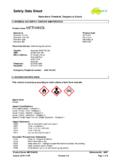Transcription of ORGANIC SOLVENTS IN THE PHARMACEUTICAL INDUSTRY - …
1 Acta Poloniae Pharmaceutica Drug Research, Vol. 67 No. 1 pp. 3 12, 2010 ISSN 0001-6837 Polish PHARMACEUTICAL SocietyOrganic SOLVENTS are constantly present in thepharmaceutical production processes. The pharma-ceutical INDUSTRY is one of the largest users of organ-ic SOLVENTS per amount of the final product (1). Theyare usually used at any step of the synthesis pathwayof an active substance or excipients, and sometimesduring the drug product formulation of some physical and chemical barriers, ORGANIC SOLVENTS cannot be completely eliminatedfrom the product by manufacturing practices, suchas drying in an elevated temperature underdecreased pressure or by lyophilization (freeze-dry-ing).
2 Usually some small amounts of SOLVENTS mayremain in the final product. They are called residualsolvents (RS), also commonly known as organicvolatile impurities (OVI). Additionally, a drug prod-uct may also become contaminated by ORGANIC sol-vents from packaging, warehouse storage, or fromshipping and transportation. For toxicological reasons manufacturers aspireto minimize the number and amount of solventsapplied in a drug production. Apart from the factthat they have no therapeutical value and may betoxic, they may additionally accelerate decomposi-tion of the product.
3 Special directions published inpharmacopeias and ICH guidelines determine maxi-mum allowable amounts of RS in pharmaceuticalproducts (2-4). If amounts of RS are below the lim-its the analyzed product is cleared for sale. In this article, many aspects of ORGANIC solventsuse in drug product development and manufacturingare presented (acceptable limits and regulations,synthesis, formulation, production, packaging, sol-vents removal, analytical methods) and new ideas oftheir replacement with the technologies used inother industries will be mentioned.
4 Regulations/legislationsGenerally, for objective reasons, the pharma-ceutical INDUSTRY is a tightly regulated branch ofmanufacturing. That is the reason why, based on thetoxicity of individual SOLVENTS , RS limits for phar-maceutical products and excipients have been set bydifferent the past, the PHARMACEUTICAL INDUSTRY neededto unify regulations and limits for residual many years the United States Pharmacopoeiawas the only pharmacopoeia setting limits for resid-ual SOLVENTS in PHARMACEUTICAL products (chapter<467> ORGANIC Volatile Impurities).
5 In 1990, limitsfor RS were proposed in Pharmeuropa (5) and, morerecently, in the second International Conference onHarmonization of Technical Requirements forRegistration of Pharmaceuticals for Human Use(ICH) guideline draft. In December 1997 the ICHpublished its Guidance for INDUSTRY Q3C whichbecame effective in March 1998. ICH guidelinecompromised regulatory authorities from Europe,REVIEWORGANIC SOLVENTS IN THE PHARMACEUTICAL INDUSTRYKATARZYNA GRODOWSKA1,2* and ANDRZEJ PARCZEWSKI11 Jagiellonian University, Faculty of Chemistry, Department of Analytical Chemistry, Ingardena 3, 30-060 Krak w, Poland2 Pliva Krak w , Mogilska 80, 31-546 Krak w, PolandAbstract: ORGANIC SOLVENTS are commonly used in the PHARMACEUTICAL INDUSTRY as reaction media, in separationand purification of synthesis products and also for cleaning of equipment.
6 This paper presents some aspects oforganic SOLVENTS utilization in an active PHARMACEUTICAL ingredient and a drug product manufacturing residual SOLVENTS are not desirable substances in a final product, different methods for their removal may beused, provided they fulfill safety criteria. After the drying process, analyses need to be performed to check ifamounts of SOLVENTS used at any step of the production do not exceed acceptable limits (taken from ICHG uideline or from pharmacopoeias). Also new SOLVENTS like supercritical fluids or ionic liquids are developedto replace traditional ORGANIC SOLVENTS in the PHARMACEUTICAL production processes.
7 Keywords: ORGANIC SOLVENTS , residual SOLVENTS , acceptable limits3* Corresponding author: GRODOWSKA and ANDRZEJ PARCZEWSKIJ apan and the United States, as well as representa-tives of the research based PHARMACEUTICAL to Q3C guideline SOLVENTS are divid-ed into four groups (2). The first group (Class 1)contains known human carcinogens, compoundsstrongly suspected of being human carcinogens, andenvironmental hazards Table 1. These solventsshould be avoided, unless strongly justified. Thelimits for Class 1 SOLVENTS are listed as absolute partsper million in a material under testing (drug orexcipient).
8 Class 2 SOLVENTS presented in Table 2ought to be limited because they are non-genotoxicanimal carcinogens or possible causative agents ofirreversible toxicity, such as neurotoxicity or terato-genicity. They are also suspected of other signifi-cant, reversible toxicities. Class 2 SOLVENTS limitsare listed in two ways (2). Option 1 uses the absoluteparts per million of SOLVENTS contained in the mate-rial being tested and is used in cases where the dailydose is known or fixed and is expressed by the for-mula:Concentration (ppm) = (1000 PDE)/dose (in grams per day) (2)where: PDE permissible daily exposure limit Option 2, the sum of amounts of residualsolvents present in each component of the drugproduct per day, should be less than given by ICH Q3C guideline has illustrative tables show-ing a passing and failing Option 2 scenario.
9 If a sam-ple fails Option 1, but passes Option 2 criteria, thenit passes the residual SOLVENTS requirement. If a sam-ple fails both Option 1 and Option 2 criteria then itfails the residual SOLVENTS 3 SOLVENTS have permissions of dailyexposures of 50 mg ( ) or less (corresponding to5000 ppm or under Option 1 described forClass 2) per day. Higher amounts may also beacceptable when the manufacturer proves that theamounts of Class 3 solvent is realistic with relationto manufacturing capability and good manufactur-ing practice. There is no solvent recognized as ahuman health hazard at levels normally accepted inpharmaceuticals in this group.
10 They are less toxic inacute or short-term studies, and negative in geno-toxicity is also another group Class 4 this group there is no adequate toxicologicaldata enabling formulation of acceptable limits. Ifmanufacturers want to use Class 4 SOLVENTS , theyshould supply justification for residual levels of thisclass SOLVENTS in a PHARMACEUTICAL product (2). As with other guidelines, Q3C only addressesmarketed products and not materials used in SOLVENTS which are most commonlyused in the chemical INDUSTRY are presented in Table reasons for control of residual solventsToxicity is the main and unquestionable reasonfor control of residual solvent amounts, but some-times the presence of RS at levels well withinacceptable limits, could entail the risk of inducingphase transformations and jeopardizing the physico-chemical stability of an active substance.






